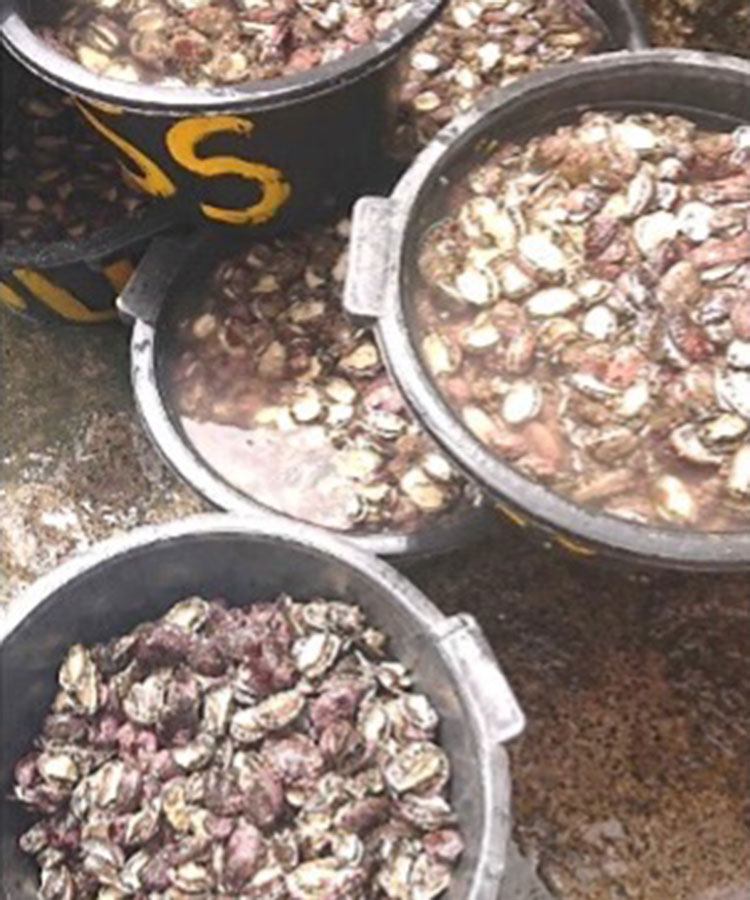Case 1-3 Sharing participatory research results with stakeholders: case of Atlantic abalone
| Key words | Atlantic abalone, CLPA Dakar Ouest, participatory survey, shell length, selective harvest, set closed season |
| Context | The divers of CLPA Dakar Ouest and others requested assistance to conduct resource management activities because both the size of abalone collected and the amount harvested have decreased in recent years. In response, COPAO, a JICA project, with the Department of Fisheries staff, held discussions with key members of the said CLPA from May 2022. To understand the resource status of abalone as they verbally described it, COPAO worked with divers there to measure the dimensions of the landed abalone at several landing sites and shared the results with the CLPA members. |
| Content | Identification of issues The size of Atlantic abalone, the main target of the dive fishery, has been getting smaller in recent years, and the time available for collection has been getting shorter. Since 2016, the size of the abalone has been even smaller. In a May 2022 meeting with relevant stakeholders in Yoff, it was stated that 40-mm abalone accounted for 10% and 30-mm abalone for 90% of the amount harvested. If this is the reality, then the Atlantic abalone stocks have been considerably depleted and the stage of selective harvesting (harvesting only the abalone above a certain size) has already passed, forcing the fishermen to resort to resource management methods such as fishing bans with set fishing seasons. The fishermen believe that this is due to overfishing and the fact that even small abalone are being harvested. Based on the findings above, with members of CLPA Dakar Ouest, the COPAO team decided that it was necessary to measure the dimensions of the harvested Atlantic abalone at several landing sites to determine the actual size of the abalone collected, and to reconcile the residents’ perception of the Atlantic abalone resources with the resource status. Dimensional measurements of Atlantic abalone Un échantillonnage aléatoire de 465 ormeaux de l’Atlantique débarqués à Ngor, Yofu et Wakamu en mai-juin 2022 a été réalisé (128 Ngor, 130 Yofu et 207 Wakamu) et la longueur de leur coquille a été mesurée. Les résultats ont montré que sur les 465 individus échantillonnés, 11 % mesuraient moins de 40 mm, 25 % moins de 45 mm et 50 % moins de 50 mm (Figure X).  Discrepancy between perception and reality When measuring shell length, the shells appeared to be smaller than their actual dimensions; thus, a little ingenuity was required to sort them. It is possible that the fishermen at the meeting in Yoff said the average shell length of the shellfish was 30–40 mm, which was visually perceived as 30–40 mm when the actual shell length was 50 mm. Based on the experience in measuring abalone in the field, it is difficult to visually distinguish 30–50 mm abalone in the sea or on the beach. On the other hand, abalone measuring 60–70 mm are clearly larger and easier to recognize. The discrepancy between the fishermen’s perception of the size of the Atlantic abalone sampled and the actual shell length is probably due to the difficulty of visually identifying the smaller abalone.   |
| Lessons Learned | There may be a discrepancy between the residents’ perception of the status of a particular resource and the actual status of the resource. In such cases, it is possible to correct the discrepancy by conducting a feasible fact-finding survey with the participation of local residents and sharing the results with them, thereby providing an opportunity to lead resource management activities in a more effective direction. |
| Guideline chapter relevant to this case study | Chapter 1 Identifying the challenges of resource management activities and coordinating stakeholder interests 1.1 Identification of resource management challenges (4) Share the challenges identified with stakeholders |
| Situation to which this case study could refer | In this case study, the issues of the diminishing size of the Atlantic abalone collection and the shortening collection period had become apparent, causing concern among the divers. Therefore, although there was a consensus that resource management activities were necessary, there was a discrepancy between the actual resource status and the divers’ perception of the current situation. Participatory surveys were effectively used to correct the discrepancies and to make resource management activities more effective. This case study will be helpful in clarifying issues and exploring the direction of resource management. |